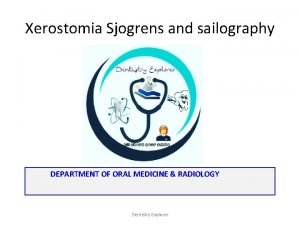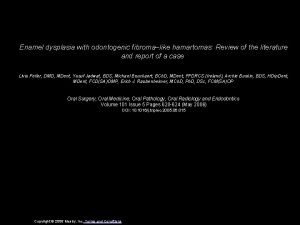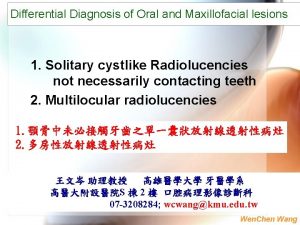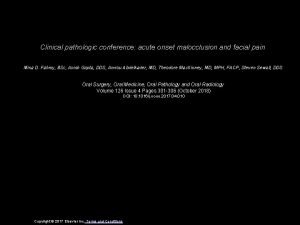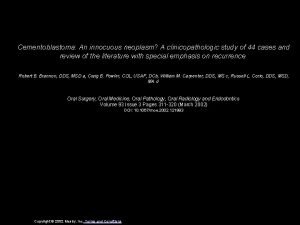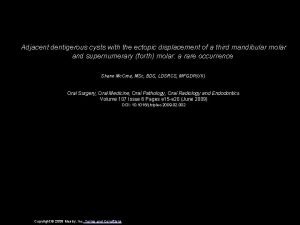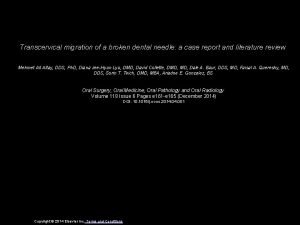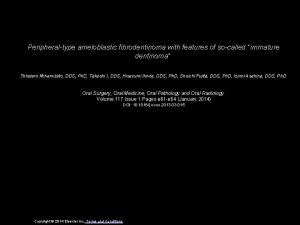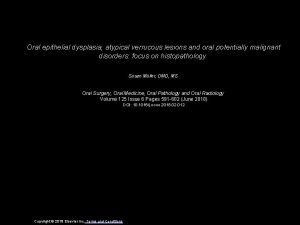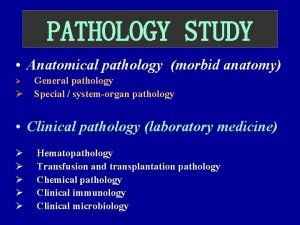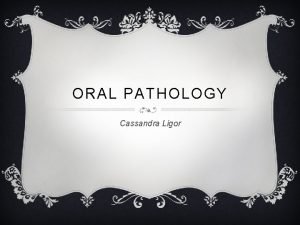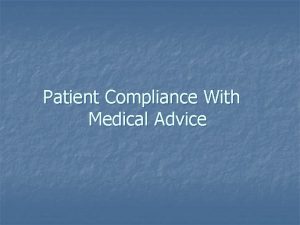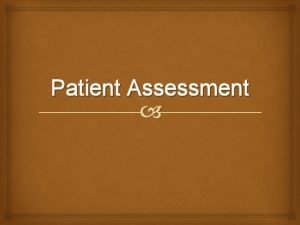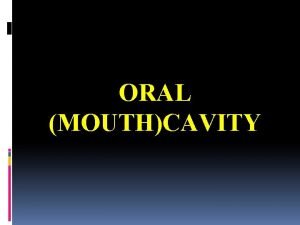Oral Pathology Project 1282014 Medical History Patient History













- Slides: 13

Oral Pathology Project 12/8/2014

Medical History Patient History Medications 60 years old Weekly methotrexate injections (RA) Hispanic (Dominican) 5 mg of Prednisone daily (RA) Female Levothyroxine for hypothyroidism Non smoker Gabapentin for pain Non drinker History of rheumatoid arthritis ( 3 years) History of hypothyroidism (4 years) History of anemia History of Meniere’s syndrome (15 years) Inadequate home care Folic Acid OTC iron supplements 4000 ICU of Vitamin D Melatonin for sleep 50 mg Sertraline (Zoloft) for anxiety

Intraoral Exam During routine screening a lesion was found on the left ventricle of the tongue. The patient also had fissured tongue. Hyperkeratinzation of on the laterals of the tongue Unilateral linea alba on the right side of mucosa Macroglossia (An enlarged tongue)

Description of Lesion 5 x 4 MM length and width 3 MM in height Shiny and smooth Pedunculated Palpable White and opaque areas Raised and protruding Rounded, even borders

How long has it been there? The patient reports she has been aware of the lesion for almost 2 and half years now. She explains the lesion appeared a couple months after she had extensive dental work done consisting of crown and bridges. The second and third quadrant where the lesion is found consists of all crowns and bridge work. The patient did not think anything of lesion because it does not hinder her day to day life.

Symptoms No pain reported Palpable mass Salivary glands WNL Oropharynx /Larynx WNL Voice WNL No dysphagia was reported Lymph nodes of the neck WNL Enlarged thyroid

The Next Step On Call dentist was consulted Measurements were taken Intraoral pictures were taken. Patient was informed of lesion Patient advised to have lesion removed. Treatment was unable to be completed due to lack of time remaining in the semester.

Differential Diagnosis #1 Traumatic (Irritation) fibroma Persistent, dense, scar-like, exophytic connective tissue Appearance: Opaque and white Cause: Chronic trauma An “episode” of trauma Size: Very small, usually less than 1 cm Location: Buccal mucosa (most common site) Tongue Lips Palate Treatment: Surgical excision Microscopic evaluation should be performed if cause of fibroma is unknown.

Differential Diagnosis #2 Neurofibroma/Schwannoma Benign tumors derived from nerve tissues. Size: Not gender or age specific. Location: Appearance: Varies from patient to patient. Tongue (most common site) Sessile, firm, pink nodules Buccal mucosa May be solitary or multiple lips Connective tissue capsules the schwannoma. Found on other areas of the body Cause: Proliferation of peripheral nerve components. Macroglossia. Treatment: Surgical excision

Differential Diagnosis #3 Lipoma Benign tumor of mature adipose (fat) cells Patients over 40, no gender predilection Appearance Yellow large mass covered by a thin layer of epithelial tissue Size: varies from patient to patient but can be very large in size. Location Buccal mucosa (most common site) Vestibule Tongue Treatment: Surgical excision

Discussion Through the intraoral exam, dental charting assessment and periodontal assessment it was determined the patient had extensive dental work performed that caused the fibroma to appear. Some of the tissue at the lingual molars had receded exposing the left ventral side of tongue to the metal of the metal infused porcelain. Even though the patient did not experience any pain or discomfort the tissue of the tongue was being constantly irritated and therefore the fibroma was produced in response to this chronic irritation as a form of protection. Neurofibroma could have been the cause because of the macroglossia but the patient reports to have had an enlarged tongue for years and did not have any lesions on her tongue. Lipoma is the third diagnosis because a lipoma on the tongue is rare and is usually much larger what the patient presents.

References Ibsen, Olga, and Joan Phelan. "Inflammation and Repair. " Oral Pathology for the Dental Hygienist. Sixth ed. 60, 61, 242 and 243. Print. Langlais, Robert, Craig Miller, and Jill Nield-Gehrig. Color Atlas of Common Oral Diseases. Fourth ed. 92 and 158. Print.

MUCHAS GRACIAS!!! Darline Pimentel MCC Dental Hygiene Clinic Patient information was kept private in accordance with HIPAA regulations.
